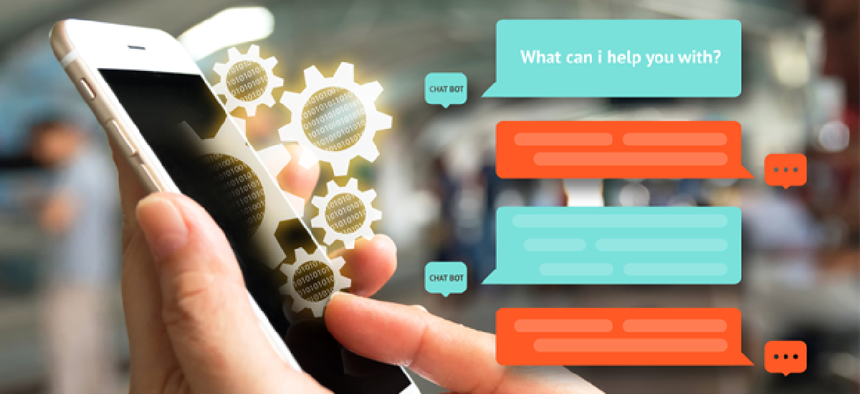How AI-powered self-service helps agencies during COVID-19


Connecting state and local government leaders
Automating routine service tasks to better support citizens and employees will be key to increasing resilience during the pandemic.
Now more than ever, citizens are depending on government agencies for critical services and information to manage their health, safety and livelihood. However, many agencies have struggled to keep up with the influx of calls and requests from residents during COVID-19, and these challenges have emphasized the importance of adopting digital tools that can improve efficiencies.
Our new survey finds that more than half of IT decision makers in the government sector (58%) expect to increase their investments in artificial intelligence and automation as a result of the crisis. They plan to invest in solutions such as chatbots, IT help desk applications and voice-based self-service to increase employee productivity, improve their ability to meet customer demands and reduce service costs.
Let’s take a closer look at how government organizations can successfully implement some of these solutions during the pandemic.
Smarter self-service
With government employees and resources stretched to the max, deploying self-service automation solutions like intelligent virtual agents can help citizens get the information and the support they need more quickly. IVAs are AI-enabled applications that can emulate human customer service staff and "talk" to citizens using speech, chat or text interfaces. Virtual agents can also complete routine tasks and transactions, such as processing a bill payment or scheduling an appointment. IVAs empower citizens to resolve many of their service requests any time of day or night without waiting, and they free up live service agents to focus on the more complicated conversations that require human intervention.
Virtual agents can also use speech recognition and natural language processing to provide a more conversational self-service experience, and their multilingual capabilities make them a natural choice for government agencies seeking to automate support for their constituents. Some of the most common and beneficial public sector use cases for this technology include applications for answering frequently asked questions, checking the status of unemployment claims, sending outbound text notifications during emergencies and processing payments. More than three-fourths of government IT decision makers (76%) in our survey agreed that automating more of these types of tasks would benefit their workforce, and 56% agreed that service automation has already helped them improve customer relationships.
For example, one large state agency uses IVAs to process payments for several services, including driver’s license renewals and auto registration fees. The IVAs handle 25,000 transactions per day, with 25% of them occurring outside of regular business hours. As a result, the agency has been able to reallocate 35 of its full-time call center agents, saving hundreds of thousands of dollars each month in labor costs, while ensuring that payments comply with Payment Card Industry Data Security Standard regulations. The application yielded an ROI payback for the organization within two weeks.
Deploying IVAs successfully
The top barrier to adopting automation technology for government IT leaders is their reliance on professional services organizations for implementation. Cost and time to development are also common hurdles.
Deploying AI-powered self-service, particularly speech-enabled IVAs, has traditionally required heavy development resources to license, install, manage and tune on-premise software and equipment. These projects could easily exceed $1 million and take several months to get up and running. To streamline costs and simplify development, IT teams often commit to a structured framework that is neither agile nor adaptable.
Fortunately, new, self-managed development tools are making it much easier for agencies to deploy IVAs at lower price points (thousands instead of millions) and in less time (days instead of months), eliminating the need for extended professional services contracts. They also give agencies more control over their virtual agent applications so they can make updates without re-engaging outside developers and can respond to changes in real-time.
Self-managed development platforms often provide code-free tools that even non-technical business users can use to design IVA applications. These solutions also typically have pre-built IVA templates that users can easily customize to create a working application within minutes. When choosing a self-managed platform, agencies should look for solutions that offer free tutorials and training resources.
IT decision makers should also consider omni-channel IVA solutions that allow users to build a self-service application once and deploy it across voice, web chat and messaging platforms. With this approach, the applications share back-end resources (data stores, payment gateways, etc.), enabling them to remain “contextually aware” as a customer switches between channels or escalates to a live service representative. This is important because a chatbot or IVA should be able to escalate to a human agent as required and pass on the context of an interaction so that a customer feels that engaging with the chatbot or IVA was worthwhile in the first place.
Final thoughts
The majority of government organizations agree that automating routine service tasks to better support citizens and employees will be key to increasing resilience during the pandemic. Nearly three-fourths (74%) of IT decision makers in the public sector agree tools that allow them to build and manage their own applications are important to their automation strategy. Using self-managed IVA development platforms can help agencies deploy service automation quickly and cost-effectively so their communities can count on them when it matters most.




